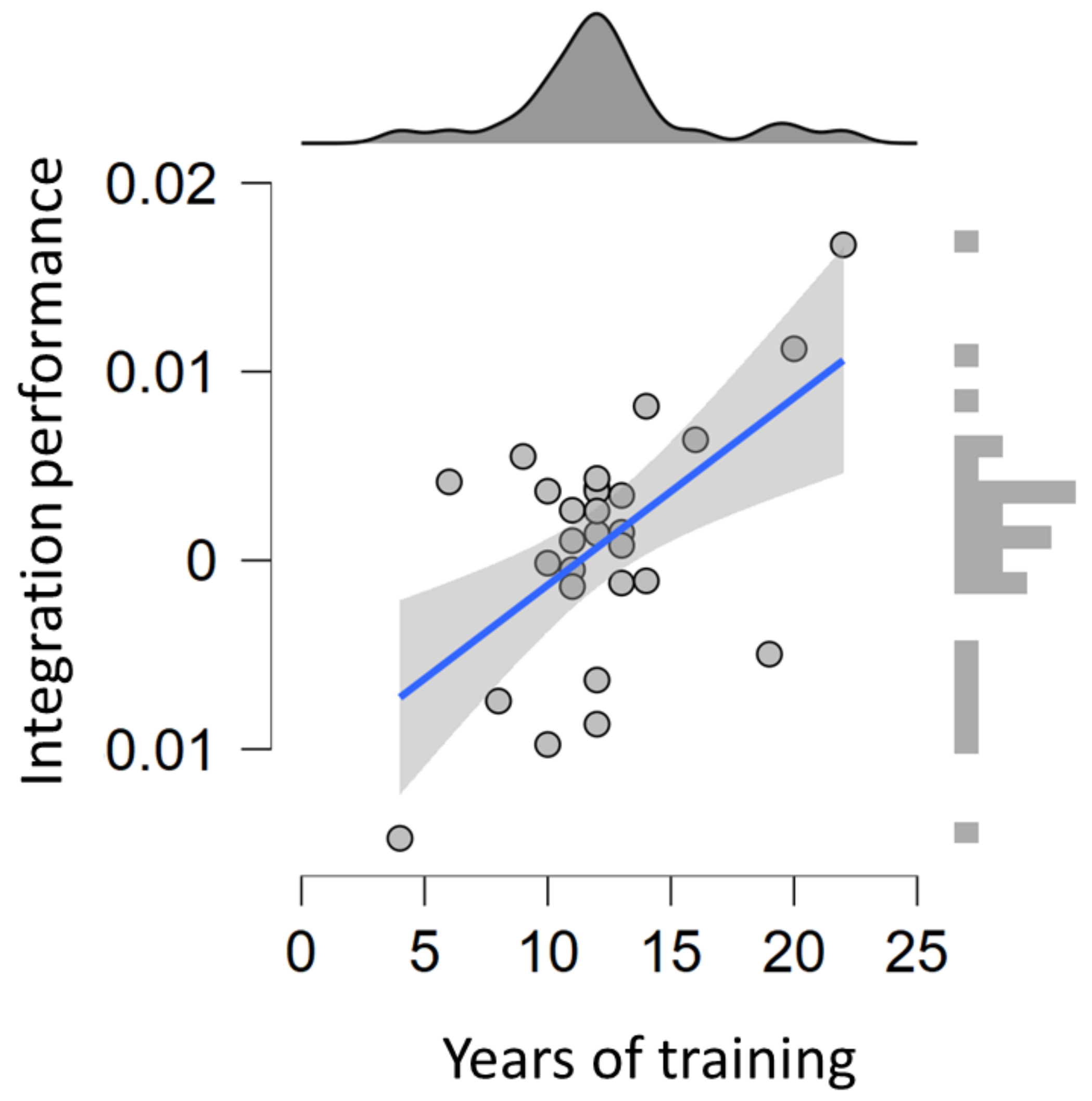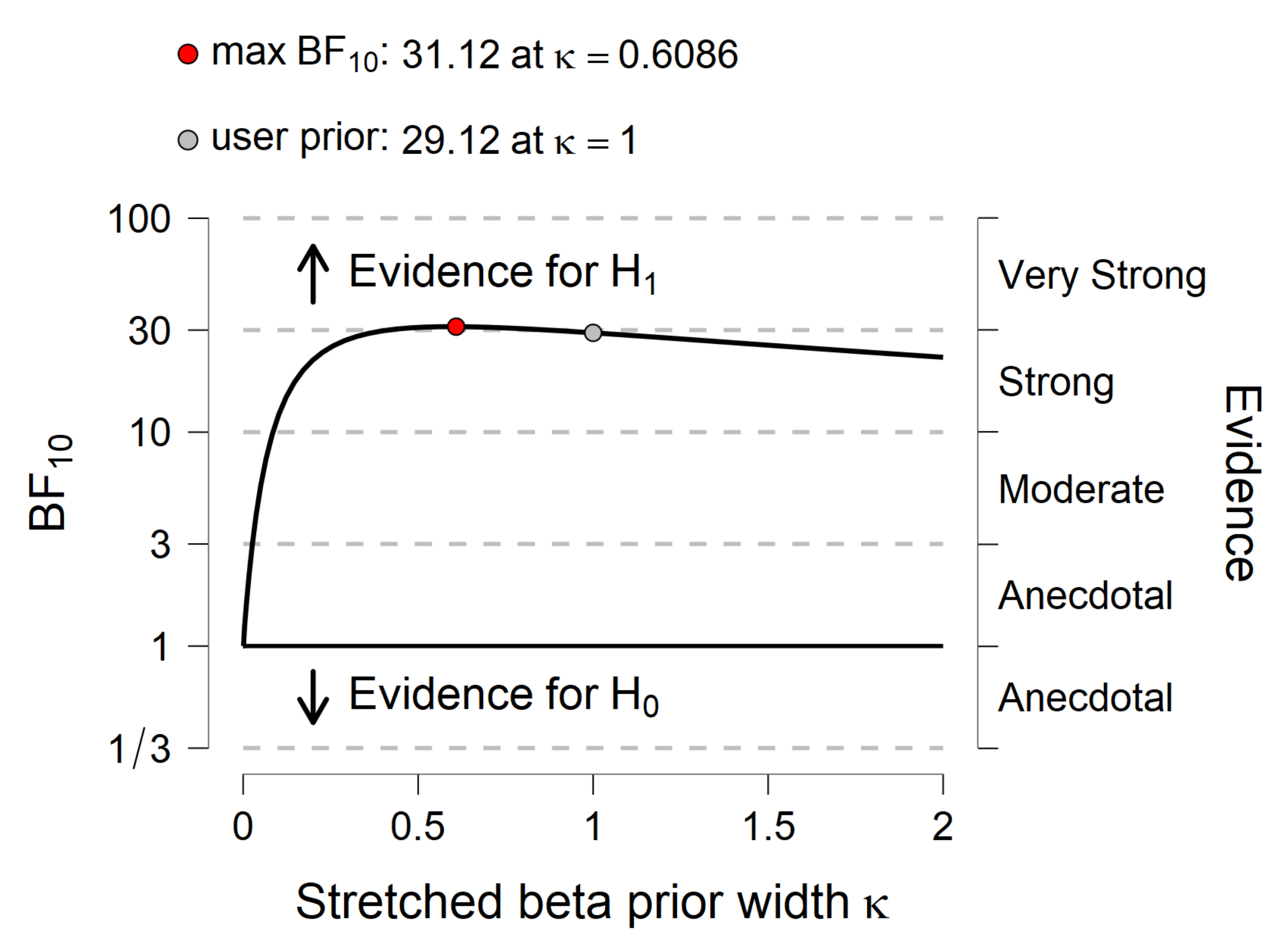Training-Associated Superior Visuomotor Integration Performance in Elite Badminton Players after Adjusting for Cardiovascular Fitness
Abstract
:1. Introduction
2. Materials and Methods
2.1. Participants
2.2. Physical Fitness Assessment
2.3. Compensatory Tracking Task: Visuomotor Integration
2.4. Time/Movement Estimation Task: Temporal Prediction
2.5. Experimental Apparatus
2.6. Experimental Procedures
2.7. Statistical Analysis
3. Results
3.1. Demographic Information
3.2. Behavioral Performances
3.3. Correlation Analysis
4. Discussion
5. Conclusions
Author Contributions
Funding
Institutional Review Board Statement
Informed Consent Statement
Data Availability Statement
Acknowledgments
Conflicts of Interest
References
- Phomsoupha, M.; Laffaye, G. The Science of Badminton: Game Characteristics, Anthropometry, Physiology, Visual Fitness and Biomechanics. Sport. Med. 2015, 45, 473–495. [Google Scholar] [CrossRef]
- Hirschfeld, H. Motor control of every day motor tasks: Guidance for neurological rehabilitation. Physiol. Behav. 2007, 92, 161–166. [Google Scholar] [CrossRef]
- Crawford, J.D.; Medendorp, W.P.; Marotta, J.J. Spatial transformations for eye-hand coordination. J. Neurophysiol. 2004, 92, 10–19. [Google Scholar] [CrossRef]
- Henriques, D.Y.P.; Medendorp, W.P.; Khan, A.Z.; Crawford, J.D. Visuomotor Transformations for Eye-Hand Coordination. In Proceedings of the Progress in Brain Research; Hyönä, J., Munoz, D.P., Heide, W., Radach, R., Eds.; Elsevier Science: Amsterdam, The Netherlands, 2002; Volume 140, pp. 329–340. [Google Scholar]
- Carey, D.P. Eye-hand coordination: Eye to hand or hand to eye? Curr. Biol. 2000, 10, R416–R419. [Google Scholar] [CrossRef] [Green Version]
- Dane, S.; Hazar, F.; Tan, Ü. Correlations between eye-hand reaction time and power of various muscles in badminton players. Int. J. Neurosci. 2008, 118, 349–354. [Google Scholar] [CrossRef]
- Wong, T.K.K.; Ma, A.W.W.; Liu, K.P.Y.; Chung, L.M.Y.; Bae, Y.H.; Fong, S.S.M.; Ganesan, B.; Wang, H.K. Balance control, agility, eye-hand coordination, and sport performance of amateur badminton players: A cross-sectional study. Medicine 2019, 98, e14134. [Google Scholar] [CrossRef]
- Dube, S.P.; Mungal, S.U.; Kulkarni, M.B. Simple visual reaction time in badminton players: A comparative study. Natl. J. Physiol. Pharm. Pharmacol. 2015, 5, 18–20. [Google Scholar] [CrossRef] [Green Version]
- Nobusako, S.; Sakai, A.; Tsujimoto, T.; Shuto, T.; Nishi, Y.; Asano, D.; Furukawa, E.; Zama, T.; Osumi, M.; Shimada, S.; et al. Deficits in visuo-motor temporal integration impacts manual dexterity in probable developmental coordination disorder. Front. Neurol. 2018, 9, 114. [Google Scholar] [CrossRef] [Green Version]
- Miles, C.A.L.; Wood, G.; Vine, S.J.; Vickers, J.N.; Wilson, M.R. Quiet eye training facilitates visuomotor coordination in children with developmental coordination disorder. Res. Dev. Disabil. 2015, 40, 31–41. [Google Scholar] [CrossRef]
- Bluechardt, M.H.; Wiener, J.; Shephard, R.J. Exercise Programmes in the Treatment of Children with Learning Disabilities. Sport. Med. 1995, 19, 55–72. [Google Scholar] [CrossRef]
- Flavell, J.C.; Barrett, B.T.; Buckley, J.G.; Harris, J.M.; Scally, A.J.; Beebe, N.B.; Cruickshank, A.G.; Bennett, S.J. Temporal estimation in prediction motion tasks is biased by a moving destination. J. Vis. 2018, 18, 5. [Google Scholar] [CrossRef] [Green Version]
- Williams, A.M.; Ward, P.; Knowles, J.M.; Smeeton, N.J. Anticipation skill in a real-world task: Measurement, training, and transfer in tennis. J. Exp. Psychol. Appl. 2002, 8, 259–270. [Google Scholar] [CrossRef]
- Chang, Y.K.; Chi, L.; Etnier, J.L.; Wang, C.C.; Chu, C.H.; Zhou, C. Effect of acute aerobic exercise on cognitive performance: Role of cardiovascular fitness. Psychol. Sport Exerc. 2014, 15, 464–470. [Google Scholar] [CrossRef] [Green Version]
- Åberg, M.A.I.; Pedersen, N.L.; Torén, K.; Svartengren, M.; Bäckstrand, B.; Johnsson, T.; Cooper-Kuhn, C.M.; Åberg, N.D.; Nilsson, M.; Kuhn, H.G. Cardiovascular fitness is associated with cognition in young adulthood. Proc. Natl. Acad. Sci. USA 2009, 106, 20906–20911. [Google Scholar] [CrossRef] [Green Version]
- Piercy, K.L.; Troiano, R.P.; Ballard, R.M.; Carlson, S.A.; Fulton, J.E.; Galuska, D.A.; George, S.M.; Olson, R.D. The physical activity guidelines for Americans. JAMA-J. Am. Med. Assoc. 2018, 320, 2020–2028. [Google Scholar] [CrossRef]
- Mezzani, A. Cardiopulmonary Exercise Testing: Basics of Methodology and Measurements. Ann. Am. Thorac. Soc. 2017, 14, S3–S11. [Google Scholar] [CrossRef]
- Plein, S.; Mahmoud, I. Stress Testing. In Basic Principles of Cardiovascular MRI: Physics and Imaging Technique; Springer: Cham, Switzerland, 2015; pp. 193–209. ISBN 9783319221410. [Google Scholar]
- Pollock, M.L.; Bohannon, R.L.; Cooper, K.H.; Ayres, J.J.; Ward, A.; White, S.R.; Linnerud, A.C. A comparative analysis of four protocols for maximal treadmill stress testing. Am. Heart J. 1976, 92, 39–46. [Google Scholar] [CrossRef]
- Makeig, S.; Jolley, K. Comptrack: A Compensatory Tracking Task for Monitoring Alertness; Naval Health Research Center: San Diego, CA, USA, 1995; Volume 30020, pp. 1–13. [Google Scholar]
- Mueller, S.T.; Piper, B.J. The Psychology Experiment Building Language (PEBL) and PEBL Test Battery. J. Neurosci. Methods 2014, 222, 250–259. [Google Scholar] [CrossRef] [Green Version]
- Heenan, M.L.; Scheidt, R.A.; Beardsley, S.A. Visual and proprioceptive contributions to compensatory and pursuit tracking movements in humans. Eng. Med. Biol. Soc. 2011, 2011, 7356–7359. [Google Scholar]
- Jerison, H.H.; Crannell, C.W.; Pownall, D. Acoustic Noise and Repeated Time Judgements in a Visual Movement Protection Task; Technical Report WADC-TR-57-54; Wright Air Development Center, Wright-Patterson Air Force Base: Dayton, OH, USA, 1957. [Google Scholar]
- Webb, C.M.; Estrada, A.; Athy, J.R. Motion sickness prevention by an 8-Hz stroboscopic environment during air transport. Aviat. Space Environ. Med. 2013, 84, 177–183. [Google Scholar] [CrossRef]
- Fletcher, G.F.; Balady, G.J.; Amsterdam, E.A.; Chaitman, B.; Eckel, R.; Fleg, J.; Froelicher, V.F.; Leon, A.S.; Piña, I.L.; Rodney, R.; et al. Exercise standards for testing and training: A statement for healthcare professionals from the American Heart Association. Circulation 2001, 104, 1694–1740. [Google Scholar] [CrossRef] [Green Version]
- Cameron, A.C.; Windmeijer, F.A.G. An R-squared measure of goodness of fit for some common nonlinear regression models. J. Econom. 1997, 77, 329–342. [Google Scholar] [CrossRef]
- Morey, R.D.; Rouder, J.N.; Jamil, T. Package ‘BayesFactor’ R Package, version 0.9.12-2; GitHub: San Francisco, CA, USA, 2015. [Google Scholar]
- Van Doorn, J.; van den Bergh, D.; Böhm, U.; Dablander, F.; Derks, K.; Draws, T.; Etz, A.; Evans, N.J.; Gronau, Q.F.; Haaf, J.M.; et al. The JASP guidelines for conducting and reporting a Bayesian analysis. Psychon. Bull. Rev. 2021, 28, 813–826. [Google Scholar] [CrossRef]
- Keysers, C.; Gazzola, V.; Wagenmakers, E.J. Using Bayes factor hypothesis testing in neuroscience to establish evidence of absence. Nat. Neurosci. 2020, 23, 788–799. [Google Scholar] [CrossRef]
- Heremans, E.; Helsen, W.F.; Feys, P. The eyes as a mirror of our thoughts: Quantification of motor imagery of goal-directed movements through eye movement registration. Behav. Brain Res. 2008, 187, 351–360. [Google Scholar] [CrossRef]
- Mann, D.L.; Runswick, O.R.; Allen, P.M. Hand and Eye Dominance in Sport: Are Cricket Batters Taught to Bat Back-to-Front? Sport. Med. 2016, 46, 1355–1363. [Google Scholar] [CrossRef] [Green Version]
- Ellison, P.; Jones, C.; Sparks, S.A.; Murphy, P.N.; Page, R.M.; Carnegie, E.; Marchant, D.C. The effect of stroboscopic visual training on eye–hand coordination. Sport Sci. Health 2020, 16, 401–410. [Google Scholar] [CrossRef] [Green Version]
- Schulte, T.; Müller-Oehring, E.M. Contribution of callosal connections to the interhemispheric integration of visuomotor and cognitive processes. Neuropsychol. Rev. 2010, 20, 174–190. [Google Scholar] [CrossRef] [Green Version]
- Ledberg, A.; Bressler, S.L.; Ding, M.; Coppola, R.; Nakamura, R. Large-scale visuomotor integration in the cerebral cortex. Cereb. Cortex 2007, 17, 44–62. [Google Scholar] [CrossRef] [Green Version]
- Dean, H.L.; Martí, D.; Tsui, E.; Rinzel, J.; Pesaran, B. Reaction time correlations during eye-hand coordination: Behavior and modeling. J. Neurosci. 2011, 31, 2399–2412. [Google Scholar] [CrossRef]
- Laby, D.M.; Kirschen, D.G.; Govindarajulu, U.; Deland, P. The Hand-eye Coordination of Professional Baseball Players: The Relationship to Batting. Optom. Vis. Sci. 2018, 95, 557–567. [Google Scholar] [CrossRef]
- Bueti, D.; Bahrami, B.; Walsh, V.; Rees, G. Encoding of temporal probabilities in the human brain. J. Neurosci. 2010, 30, 4343–4352. [Google Scholar] [CrossRef] [Green Version]
- Kveraga, K.; Ghuman, A.S.; Bar, M. Top-down predictions in the cognitive brain. Brain Cogn. 2007, 65, 145–168. [Google Scholar] [CrossRef] [Green Version]
- Müller, S.; Fadde, P.J.; Harbaugh, A.G. Adaptability of expert visual anticipation in baseball batting. J. Sports Sci. 2017, 35, 1682–1690. [Google Scholar] [CrossRef]
- Aglioti, S.M.; Cesari, P.; Romani, M.; Urgesi, C. Action anticipation and motor resonance in elite basketball players. Nat. Neurosci. 2008, 11, 1109–1116. [Google Scholar] [CrossRef]
- Chaddock, L.; Neider, M.B.; Voss, M.W.; Gaspar, J.G.; Kramer, A.F. Do athletes excel at everyday tasks? Med. Sci. Sports Exerc. 2011, 43, 1920–1926. [Google Scholar] [CrossRef] [Green Version]
- Starkes, J.L.; Ericsson, K.A. How the Expert Performance Approach Differs from Traditional Approaches to Expertise in Sport. In Expert Performance in Sports; Human Kinetics: Champaign, IL, USA, 2020. [Google Scholar]
- Appelbaum, L.G.; Erickson, G. Sports vision training: A review of the state-of-the-art in digital training techniques. Int. Rev. Sport Exerc. Psychol. 2018, 11, 160–189. [Google Scholar] [CrossRef]
- Fadde, P.J.; Zaichkowsky, L. Training perceptual-cognitive skills in sports using technology. J. Sport Psychol. Action 2018, 9, 239–248. [Google Scholar] [CrossRef]
- Faubert, J.; Sidebottom, L. Perceptual-cognitive training of athletes. J. Clin. Sport Psychol. 2012, 6, 85–102. [Google Scholar] [CrossRef] [Green Version]
- Faubert, J. Professional athletes have extraordinary skills for rapidly learning complex and neutral dynamic visual scenes. Sci. Rep. 2013, 3, 1154. [Google Scholar] [CrossRef] [Green Version]
- Voss, M.W.; Kramer, A.F.; Basak, C.; Prakash, R.S.; Roberts, B. Are expert athletes “expert” in the cognitive laboratory? A meta-analytic review of cognition and sport expertise. Appl. Cogn. Psychol. 2010, 24, 812–826. [Google Scholar] [CrossRef]
- Caplan, P.J.; Crawford, M.; Hyde, J.S.; Richardson, J.T.E. Gender Differences in Human Cognition; Oxford University Press: Oxford, UK, 2012; ISBN 9780199846900. [Google Scholar]
- Reilly, D.; Neumann, D.L.; Andrews, G. Gender differences in spatial ability: Implications for STEM Education and Approaches to Reducing the Gender Gap for Parents and Educators. In Visual-Spatial Ability in STEM Education: Transforming Research into Practice; Springer: Cham, Switzerland, 2017; pp. 195–224. ISBN 9783319443850. [Google Scholar]
- Tzuriel, D.; Egozi, G. Gender differences in spatial ability of young children: The effects of training and processing strategies. Child Dev. 2010, 81, 1417–1430. [Google Scholar] [CrossRef]
- Ryan, J.P.; Atkinson, T.M.; Dunham, K.T. Sports-Related and Gender Differences on Neuropsychological Measures of Frontal Lobe Functioning. Clin. J. Sport Med. 2004, 14, 18–24. [Google Scholar] [CrossRef]
- Choleris, E.; Galea, L.A.M.; Sohrabji, F.; Frick, K.M. Sex differences in the brain: Implications for behavioral and biomedical research. Neurosci. Biobehav. Rev. 2018, 85, 126–145. [Google Scholar] [CrossRef]
- Swann, C.; Moran, A.; Piggott, D. Defining elite athletes: Issues in the study of expert performance in sport psychology. Psychol. Sport Exerc. 2015, 16, 3–14. [Google Scholar] [CrossRef] [Green Version]
- Devaux, M.; Sassi, F. Social disparities in hazardous alcohol use: Self-report bias may lead to incorrect estimates. Eur. J. Public Health 2016, 26, 129–134. [Google Scholar] [CrossRef] [Green Version]
- Cassilhas, R.C.; Tufik, S.; De Mello, M.T. Physical exercise, neuroplasticity, spatial learning and memory. Cell. Mol. Life Sci. 2016, 73, 975–983. [Google Scholar] [CrossRef]



| Elite Badminton Players | |
|---|---|
| N | 28 |
| Age | 21.35 ± 2.65 |
| Education | 16.6 ± 1.6 |
| Training (years) | 12.214 ± 3.755 |
| Height | 168.8 ± 6.9 |
| Weight | 64.1 ± 7.5 |
| BMI | 22.4 ± 1.75 |
| VO2 max (mL/kg/min) | 53.3 ± 10.7 |
| HR max (bpm) | 183.8 ± 14.1 |
Publisher’s Note: MDPI stays neutral with regard to jurisdictional claims in published maps and institutional affiliations. |
© 2022 by the authors. Licensee MDPI, Basel, Switzerland. This article is an open access article distributed under the terms and conditions of the Creative Commons Attribution (CC BY) license (https://creativecommons.org/licenses/by/4.0/).
Share and Cite
Chen, Y.-L.; Hsu, J.-H.; Tai, D.H.-L.; Yao, Z.-F. Training-Associated Superior Visuomotor Integration Performance in Elite Badminton Players after Adjusting for Cardiovascular Fitness. Int. J. Environ. Res. Public Health 2022, 19, 468. https://doi.org/10.3390/ijerph19010468
Chen Y-L, Hsu J-H, Tai DH-L, Yao Z-F. Training-Associated Superior Visuomotor Integration Performance in Elite Badminton Players after Adjusting for Cardiovascular Fitness. International Journal of Environmental Research and Public Health. 2022; 19(1):468. https://doi.org/10.3390/ijerph19010468
Chicago/Turabian StyleChen, Yi-Liang, Jen-Hao Hsu, Dana Hsia-Ling Tai, and Zai-Fu Yao. 2022. "Training-Associated Superior Visuomotor Integration Performance in Elite Badminton Players after Adjusting for Cardiovascular Fitness" International Journal of Environmental Research and Public Health 19, no. 1: 468. https://doi.org/10.3390/ijerph19010468






